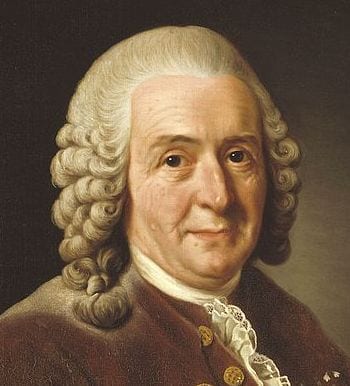
Linnaeus timeline

Painted by Alexander Roslin in 1775
Courtesy Wikimedia Commons
Linnaeus Timeline
This Linnaeus timeline is adapted and extended from that given in Blunt. For a contextual account of his life see the article in Wikipedia.
1707 – Carl Linnaeus born 23 May at Råshult Sweden. Learns about botany from his father a curate of Stenbrohult
1716 – Attends Grammar School at Växjö but a poor student playing truant to botanize
1719 – Headmaster recommends Linnaeus to Dr Johan Rothman a master at Växjö Gymnasium (High School) who encourages Linnaeus to study medicine
1721 – Swedish kingdom formerly the third largest in Europe after Russia and Spain is annexed during the Great Northern War (1700–1721), succumbing to a coalition of Russia, Denmark, Norway, Saxony, Poland, Lithuania, Hanover and Britain. Linnaeus is 14
1724 – Enters High School and does well at Maths, Physics, and spoken Latin. Learns the Tournefort plant classification of his day and becomes familiar with Sébastien Vaillant’s (of the Jardin du Roi in Paris) essay on plant sexuality Sermo de Structura Florum (1717)
1727 – At age 20 matriculates in medicine at the University of Lund
1728 – Transfers to Uppsala University medical school, assists Dean to compile a two-volume Hierobotanicon, an account of the plants of the Bible – eventually published in 1745 and 1747; from 1728-1731 he acts as a botanical demonstrator at the Uppsala Botanic Garden
1729 – Befriends zoologist Peter Artedi; meets Olof Celsius, Prof. Theology and amateur botanist who offers Linnaeus lodgings and access to his garden and library; writes Praeludia Sponsaliarum Plantarum, a paper on the sexuality of plants which draws the attention of Prof. Olof Rudbeck founder of the Uppsala Botanic Garden
1730 – Applies for job as gardener at Uppsala Botanic Garden but Rudbeck offers him the position of Plant Demonstrator; questioning the plant classification of his day Linnaeus begins work on several publications; he lives in a house in the corner of the city’s botanic gardens which he converts from a neglected collection of plants into a rectilinear grid of garden beds demonstrating the 24 classes he had created for the world’s plant species publishing a catalogue of the plants Adonis Uplandicus for the benefit of his students. He sometimes draws crowds of several hundred people to his talks including members of the nobility. Said to have increased the number of plant kinds from 300 in the 1720s to about 3000 by the 1740s
1731 – Obtains 400 copper dalers from the Royal Society of Science for a trip to Lapland
1732 – 10 month and 3000 mile journey through Lapland; publishes first part of Florula Lapponica which uses his ‘sexual system’ of classification
1735 – Travels to Europe at Hamburg in April, on to Holland in June receiving medical doctorate from the University of Harderwijk. In Amsterdam he meets Burman, Boerhaave, and Gronovius and meets up with friend Artedi at Leiden where he publishes Systema Naturae with 12 editions published between 1735 and 1768, by the time of the 10th edition in 1758 it ran into many volumes that included about 4,400 species of animals and 7,700 species of plants; meets George Clifford a wealthy director of the Dutch East India Company and given lodging at Clifford’s estate at Hartekamp near Haarlem where he is to catalogue the plants and herbarium; Artedi drowns in an Amsterdam canal
1736 – Publishes Bibliotheca Botanica and Fundamenta Botanica in Amsterdam and Musa Cliffortiana in Leiden; travels to England in July where he meets Sir Hans Sloane, Peter Collinson, Philip Miller at the Chelsea Physic Garden, visiting Oxford and the Botanic Garden (est. 1621) he meets Johann Dillenius, Sherardian Professor of Botany, and James Sherard; in August returns to Holland and begins work on Hortus Cliffortianus
1737 – Publishes Genera Plantarum and Critica Botanica in Leiden and Flora Lapponica in Amsterdam; spends winter at Leiden classifying the plants in the Leiden Botanic Garden
1738 – Publishes Hortus Cliffortianus (dated 1737) and ,em>Classes Plantarum; in May travels to Paris where he meets the three de Jussieu taxonomists Anton, Joseph and Bernard; returns to Sweden where he is engaged to Sara Lisa (who he marries in 1739) and becomes a medical practitioner in Stockholm
1741 – Offered and takes up a medical professorship at Uppsala as Professor of Botany; journeys to Öland and Gotland
1745 – Publishes Öländska och Gothländska Resa in Stockholm and Uppsala and Flora Suecica in Stockholm
1746 – Fauna Suecica published in Stockholm
1747 – Publishes Wästgöte-Resa and Flora Zeylanica in Stockholm
1748 – Publishes Hortus Upsaliensis in Stockholm
1749 – Publishes Materia Medica in Stockholm and Amoenitates Academicae in Stockholm and Leiden; journey to Skåne
1750 – The anointment of his students as ‘apostles’ sent out into the world for the cause of botany
1751 – Publishes Skåne Resa and Philosophia Botanica in Stockholm; describes zoological collections of Queen Lovisa Ulrika and King Adolf Fredrik using binomial nomenclature
1752 – Publishes Species Plantarum in Stockholm, a global Flora accepted internationally as the starting point for botanical nomenclature
1758 – Publishes 10th edition of Systema Naturae, accepted internationally as the starting point for zoological nomenclature
1761 – Is ennobled (ante-dated 1757) and assumes the name Carl Von Linné
1774 – Publishes Systema Vegetabilium in Gottingen and Gotha
1778 – Linnaeus dies on 10 January following a stroke
—
First published on the internet – 1 March 2019

